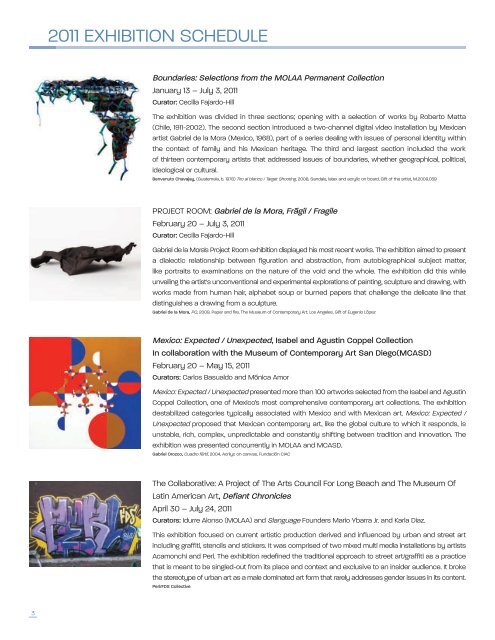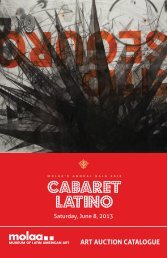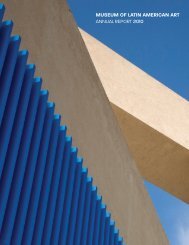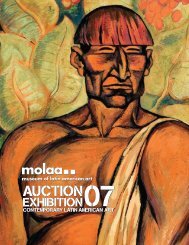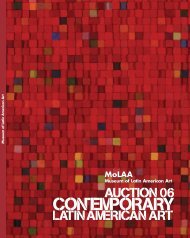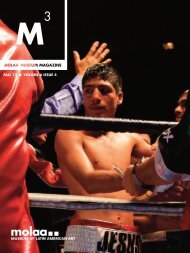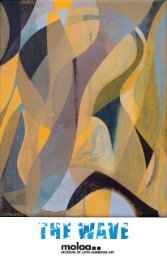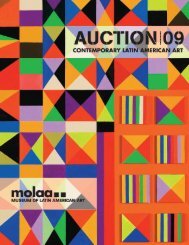MUSEUM OF LATIN AMERICAN ART
2 7 8 9 10 11 3-4 5-6 - Museum of Latin American Art
2 7 8 9 10 11 3-4 5-6 - Museum of Latin American Art
- No tags were found...
Create successful ePaper yourself
Turn your PDF publications into a flip-book with our unique Google optimized e-Paper software.
2011 EXHIBITION SCHEDULEBoundaries: Selections from the MOLAA Permanent CollectionJanuary 13 – July 3, 2011Curator: Cecilia Fajardo-HillThe exhibition was divided in three sections; opening with a selection of works by Roberto Matta(Chile, 1911-2002). The second section introduced a two-channel digital video installation by Mexicanartist Gabriel de la Mora (Mexico, 1968), part of a series dealing with issues of personal identity withinthe context of family and his Mexican heritage. The third and largest section included the workof thirteen contemporary artists that addressed issues of boundaries, whether geographical, political,ideological or cultural.Benvenuto Chavajay, (Guatemala, b. 1978) Tiro al blanco / Target Shooting, 2008, Sandals, latex and acrylic on board, Gift of the artist, M.2009.039PROJECT ROOM: Gabriel de la Mora, Frágil / FragileFebruary 20 – July 3, 2011Curator: Cecilia Fajardo-HillGabriel de la Mora’s Project Room exhibition displayed his most recent works. The exhibition aimed to presenta dialectic relationship between figuration and abstraction, from autobiographical subject matter,like portraits to examinations on the nature of the void and the whole. The exhibition did this whileunveiling the artist's unconventional and experimental explorations of painting, sculpture and drawing, withworks made from human hair, alphabet soup or burned papers that challenge the delicate line thatdistinguishes a drawing from a sculpture.Gabriel de la Mora, PQ, 2009, Paper and fire, The Museum of Contemporary Art, Los Angeles, Gift of Eugenio LópezMexico: Expected / Unexpected, Isabel and Agustín Coppel CollectionIn collaboration with the Museum of Contemporary Art San Diego(MCASD)February 20 – May 15, 2011Curators: Carlos Basualdo and Mónica AmorMexico: Expected / Unexpected presented more than 100 artworks selected from the Isabel and AgustínCoppel Collection, one of Mexico’s most comprehensive contemporary art collections. The exhibitiondestabilized categories typically associated with Mexico and with Mexican art. Mexico: Expected /Unexpected proposed that Mexican contemporary art, like the global culture to which it responds, isunstable, rich, complex, unpredictable and constantly shifting between tradition and innovation. Theexhibition was presented concurrently in MOLAA and MCASD.Gabriel Orozco, Cuadro fértil, 2004, Acrilyc on canvas, Fundación CIACThe Collaborative: A Project of The Arts Council For Long Beach and The Museum OfLatin American Art, Defiant ChroniclesApril 30 – July 24, 2011Curators: Idurre Alonso (MOLAA) and Slanguage Founders Mario Ybarra Jr. and Karla Diaz.This exhibition focused on current artistic production derived and influenced by urban and street artincluding graffiti, stencils and stickers. It was comprised of two mixed multi media installations by artistsAcamonchi and Perl. The exhibition redefined the traditional approach to street art/graffiti as a practicethat is meant to be singled-out from its place and context and exclusive to an insider audience. It brokethe stereotype of urban art as a male dominated art form that rarely addresses gender issues in its content.Perl/FDS CollectiveUnresolved Circumstances: Video Art from Latin AmericaJune 5 – August 28, 2011Curators: Cecilia Fajardo-Hill and Idurre AlonsoThe videos presented in Unresolved Circumstances explored past and present recurring issues in Latin Americathat continuously shape a contradictory reality. Presented in three thematic axes—History, Location andPolitics—the works dealt with several global and local socio-political issues relating to Latin American historysuch as colonialism and its effects, the contradictions of a dysfunctional modernity, gender issues,corruption, violence, the war on drugs, forced disappearance and consumerism, among other themes.Donna Conlon, Coexistence, 2003, Croatia video still, 5:26 minutes ©Donna ConlonPROJECT ROOM: Johanna Calle, Submergentes: A Drawing Approach on MasculinitiesJuly 14, 2011 – January 8, 2012Curator: Cecilia Fajardo-HillJohanna Calle experiments with different drawing formats and materials to produce drawings thatare conceptual in content and challenge our concept of what a drawing is, questioning the boundariesbetween drawing and sculpture or drawing and writing. Her work explores the qualities of cursivehandwriting, different writing systems of transcription such as shorthand or stenography, and theirsimilarities with drawing techniques and aesthetics, to comment on social issues, utilizing sources suchas music and literature.Johanna Calle, Submergentes: A Drawing Approach on Masculinities, 2010, Mixed media on paper, Courtesy of the artistThe Good, The Bad, The Ugly? Selections from the MOLAA Permanent CollectionJuly 14, 2011 – January 8, 2012Curator: Gabriela Martínez, Associate Vice President of EducationThis selection of works from MOLAA’s permanent collection, encouraged visitors to examine the waythat they make aesthetic judgments and the key factors that influence them in deciding whether a pieceof art is “good” or “bad.” Visitors were asked to make a value judgment on works in the exhibition andthen ask themselves why they made that decision. The exhibition examined principles of design, color,styles and strategies artists use to communicate.Alejandro Colunga (Mexico, b. 1948) La vaca de mil ojos, lloran / The Cow with a Thousand Eyes, They Cry, 1993. Oil on canvas, Robert Gumbiner Foundation Collection. F.99.08MEX/LA: “Mexican” Modernism(s) in Los Angeles 1930-1985September 18, 2011 – February 5, 2012Curators: Rubén Ortiz-Torres and Jesse LernerMEX/LA: “Mexican” Modernism(s) in Los Angeles 1930-1985 focused on the construction of different notionsof “Mexicanidad” within modernist and contemporary art created in Los Angeles. This is the place whereSiqueiros and Orozco made some of their first murals and their ideas and iconography created a seriesof archetypes that often turned into stereotypes in popular culture, which throughout time have beencontested, appropriated and reclaimed. The purpose of this exhibition was to understand how nationalismand internationalism are modernist constructions that are not necessarily exclusive but often complementaryand fundamental in the formation of Mexican, American, Chicano art and the art of the City.Graciela Iturbide (Mexico City, b. 1942), Cristina tomando fotos en Los Ángeles, CA, from the series White Fence, East L.A., ca. 1986, (detail) Gelatin silver print,2011, Courtesy of the artist and Rose Gallery, Santa Monica, CAThe Collaborative: A Project of The Arts Council For Long Beach and The Museum OfLatin American Art, Utopian City ProjectOctober 29, 2011 – February 5, 2012Curator: Idurre AlonsoUsing Long Beach as a model, this exhibition proposed a new exercise in imagining the perfect city ofthe future. Architect Giacomo Castagnola and urban planner James Rojas collaborated to create aninteractive model of Long Beach that allowed the visitors to propose their own ideas for the future of thecity. This project pushed the boundaries of the conventional architectural model, giving visitors theopportunity to view the city conceptually as well as experience it physically through the senses.3 James Rojas Re-Imagine Raleigh Workshop, 20114


